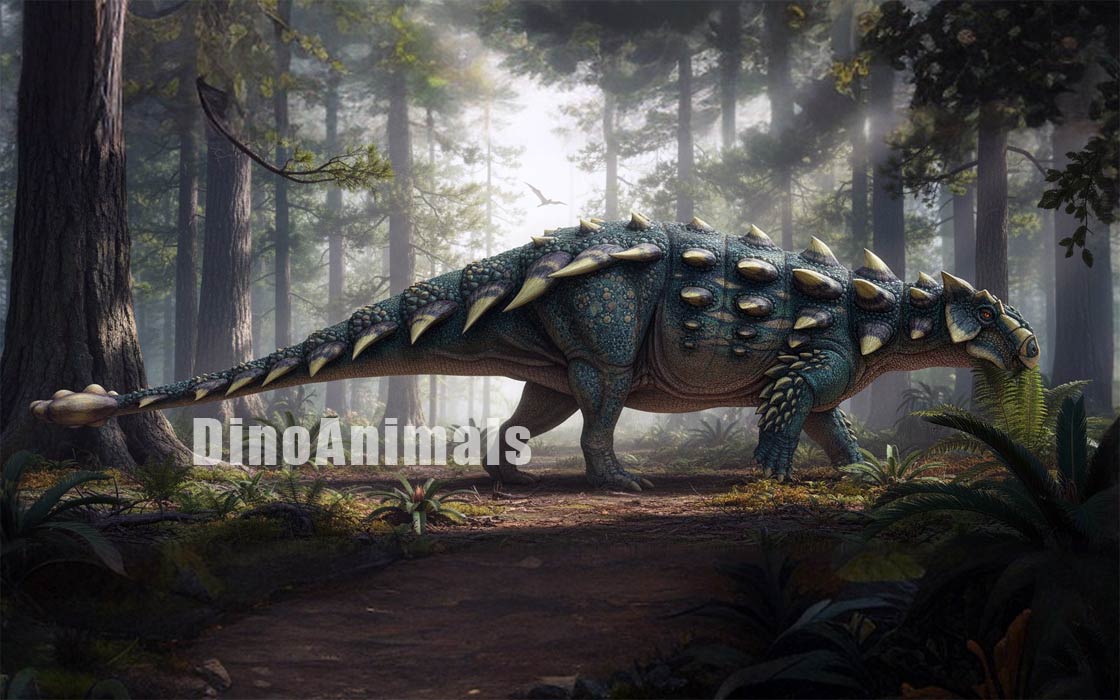Every month, 100,000 readers use the Dinosaur Database, but we receive no support from you. Developing and updating the database requires a lot of work. If you want it to remain open and be updated, please support us via the "Buy us a coffee" button available on every page or via the Support page.
Dinosaur: Zuul crurivastator

| Length*: | 6 m | 19.7 ft |
| Weight*: | 2.5 t | 5,512 lb |
*The largest known specimen
Period
Epoch: Late Cretaceous
Stage: Late Campanian
Years: 83.6–72.1 Ma
Details
Status: valid
Author: Arbour & Evans
Year: 2017
Distribution
Area: North America
Country: USA
Region: Montana
Formation: Judith River
Description
Zuul crurivastator
Zuul crurivastator was an ankylosaurine dinosaur that lived during the Late Cretaceous (Campanian stage), approximately 76.2–75.2 million years ago. It was discovered in the Coal Ridge Member of the Judith River Formation in Montana, USA. The genus name Zuul references the monster Zuul from the 1984 movie Ghostbusters, due to the skull’s resemblance to the fictional creature. The species name crurivastator is Latin for “destroyer of shins,” referring to its large, powerful tail club, which it likely used for defense.
Physical Characteristics
Zuul crurivastator was a medium to large ankylosaur, estimated to reach 6 meters (20 ft) in length and weigh around 2,500 kg (5,500 lb). It was a quadrupedal, heavily armored dinosaur with a broad, low-slung body and short, powerful limbs.
Key skeletal features include:
- Complete skull and tail club, making it the most complete ankylosaurid ever found in North America.
- Heavily ornamented skull, with pyramidal supraorbital caputegulae and imbricated frontonasal osteoderms.
- Long, laterally projecting squamosal horns, extending well past the nuchal shelf.
- Large quadratojugal horns, forming a robust, triangular structure at the sides of the skull.
- Massive tail club, dorsoventrally flattened, with a length-to-width ratio of less than 0.20.
- Lateral caudal osteoderms, which were sharply pointed and proportionally larger than those in related ankylosaurs.
The presence of preserved soft tissues, including in situ osteoderms, skin impressions, and possible remnants of keratin, makes Zuul one of the best-preserved armored dinosaurs ever discovered.
Diet and Feeding Habits
As a herbivore, Zuul crurivastator likely fed on low-growing vegetation such as ferns, cycads, and conifers. Its broad, toothless beak was well-suited for cropping plants, while its cheek teeth, arranged in a dental battery, were used to grind plant material before swallowing. Like other ankylosaurs, it may have relied on gastroliths (stomach stones) to aid in digestion.
Habitat and Distribution
Zuul crurivastator lived in what is now Montana, USA, specifically in the Judith River Formation, which was part of the coastal floodplains of Laramidia. This region featured lush floodplains, river channels, and coastal forests, providing abundant plant life for large herbivores.
The Judith River Formation was home to a diverse range of dinosaurs, including:
- Hadrosaurids (Brachylophosaurus, Prosaurolophus)
- Ceratopsids (Medusaceratops, Judithceratops)
- Tyrannosaurids (Gorgosaurus, Daspletosaurus)
- Other ankylosaurs, though Zuul is the most complete one known from the formation
The discovery of Zuul helps fill a previous gap in the ankylosaur fossil record of North America.
Behavior and Social Structure
Like other ankylosaurs, Zuul crurivastator was likely a solitary or loosely social animal, using its armored body and tail club for defense against predators. Its wide, low stance suggests it may have moved slowly, relying on its heavy armor rather than speed for protection.
The large tail club was likely used in intraspecific combat (e.g., fighting for mates or dominance) and for defense against predators like Gorgosaurus. Studies on tail biomechanics suggest ankylosaurs could deliver strong, bone-crushing blows, potentially breaking the legs of attacking theropods.
Discovery and Research
The holotype specimen (ROM 75860) was discovered in 2014 near Havre, Montana, during excavation work on a nearby tyrannosaur skeleton. The nearly complete skeleton was found articulated, with both the skull and tail club preserved—a rarity for ankylosaurids.
The fossil was described in 2017 by Victoria M. Arbour and David C. Evans in Royal Society Open Science. Phylogenetic analysis places Zuul within Ankylosaurinae, closely related to Dyoplosaurus and Scolosaurus, but more distantly related to Euoplocephalus.
Significance and Interesting Facts
- Zuul crurivastator is the most complete ankylosaurid ever found in North America, preserving both the skull and tail club.
- It had abundant soft tissue preservation, including possible keratin sheaths on osteoderms.
- It lived alongside tyrannosaurs, hadrosaurs, and ceratopsids, sharing its environment with multiple large herbivores.
- Its tail club was large and flat, suggesting it was specialized for delivering powerful defensive strikes.
- The discovery of Zuul has helped clarify ankylosaur evolution in North America, showing distinct species turnover during the Campanian
Locations
Sources
Material: Skull, mandibles, hyoid elements, cervical vertebrae, dorsal vertebrae, sacral vertebrae, caudal vertebrae, ribs, chevrons, scapulae, coracoids, sternal elements, humeri, radii, ulnae, ilia, ischia, pubes, femora, tibiae, fibulae, astragali, metapodials, phalanges, osteoderms, tail club
References: Arbour, V.M. & Evans, D.C. (2017) A new ankylosaurine dinosaur from the Judith River Formation of Montana, USA, based on an exceptional skeleton with soft tissue preservation. Royal Society Open Science 4: 161086.
Penkalski, P. (2018). Revised systematics of the armoured dinosaur Euoplocephalus and its allies.




